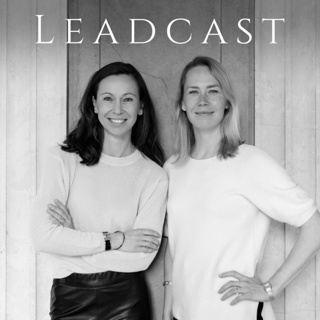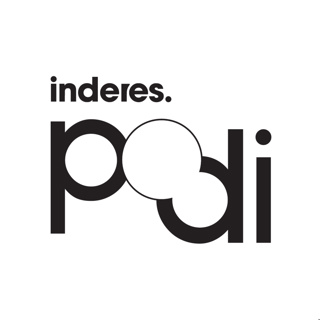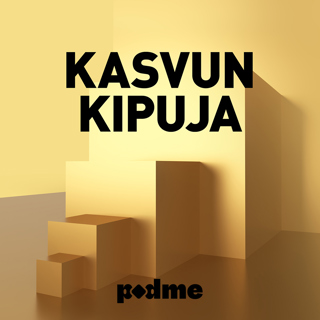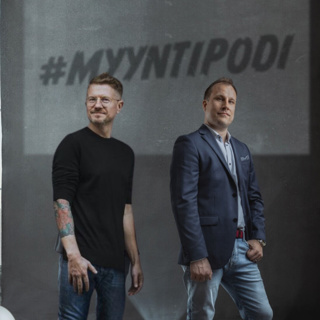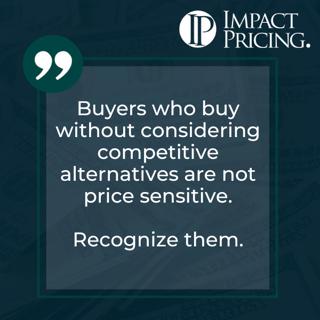
Pricing Table Topics: 8 of Clubs – Buyers Who Buy without Considering Competitive Alternatives
This one is the 8 of Clubs from the Selling Value card deck. Okay. You're wondering to yourself, do buyers ever not consider competitive alternatives? And the answer is, absolutely yes! Some easy consumer examples. When you buy popcorn at the movie theater, you couldn't buy popcorn anywhere else. Therefore, you didn't consider a competitive alternative. You just said, am I going to buy popcorn here or not? And that's why they get away with charging really high prices for popcorn. What about last gas for 75 miles, when you're in the middle of nowhere and you only have an eighth of a tank of gas left? Are you going to buy gas at that gas station that's four times the price? Heck, yes you are! And that's because they know you didn't consider a competitive alternative. There wasn't one to consider at the time. Our job as salespeople should be to try to find different customers and recognize whether they're going to be looking at, or talking to, competitive alternatives. For example, if someone was referred to you, they're probably not going to go talk to a competitive alternative. They might, but they might not. So let's treat them as though they won't. What if someone's buying an add-on to a current product they have that you've sold to them? They're probably only buying it from you. What if they're using your subscriptions and are they going to buy the upgraded package or are they even going to pay you this month for the subscription that they bought a few months ago? In each one of those decisions, they're just deciding, am I going to buy from you? But they're not saying, should I switch? Should I look at competitive alternatives? There are lots of situations, and product types, where buyers don't look at competitive alternatives. We should be focusing on finding those buyers and making sure we're not discounting, or if we have the opportunity, consider raising the price a little bit. I can almost guarantee you they won't make a different decision. We hope you enjoyed this example of Pricing Table Topics. What you just heard was done without a script. If you want to get better at speaking about pricing and value, grab a deck of our cards, pick a card, read the saying, then talk for one to two minutes about what that card says. You'll become a better speaker and expert. If you have any questions or feedback, please email me, mark@impactpricing.com. Now, go make an impact. Connect with Mark Stiving: Email: mark@impactpricing.com LinkedIn: https://www.linkedin.com/in/stiving/
8 Maalis 20233min
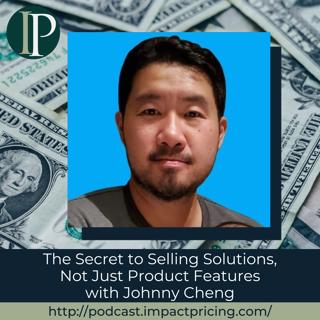
The Secret to Selling Solutions, Not Just Product Features with Johnny Cheng
Johnny Cheng is the Senior Director of Pricing and Packaging at ClickUp. He was the Senior Director of Pricing and Packaging at Coupa Software, and has years of experience in Product Marketing through various companies. In this episode, Johnny shares his knowledge and experience on product marketing and product management as he educates us on the benefits of solution pricing, especially as to how a lens test helps on creating packages. Why you have to checkout today’s podcast: Find out what crucial perspective companies miss when pricing sits in finance Learn about the benefits of having solution pricing, as well as to how you can sell value instead of features Discover a packaging system that incredibly works, both for the customers and the company “Go do the lens test. Even if your packaging is already set, I would go back and do that exercise. I feel like if you do it across different teams, you'll be very surprised at what you see.” – Johnny Cheng Topics Covered: 01:05 – How Johnny got into pricing 01:50 – Comparing the role of product management with product marketing 05:46 – Does pricing ever exist without packaging or are the two just so tightly connected? 08:33 – Johnny as a strong believer of having solution pricing 12:18 – Johnny vs. Mark on good, better, best 15:16 – The system Johnny uses to decide which features goes in which package 20:58 – Tips and tools that can help you sell value instead of features 26:56 – Salespeople discounting too much because they don’t sell the value of the product 28:47 – Johnny’s pricing advice 30:05 – Connect with Johnny Key Takeaways: “I'm seeing more and more in product marketing just exactly to your point. It's more customer driven, it's more go-to market driven, it's more value driven. And so, if you sit in product management, every feature you release is the best feature ever, right? But product marketing really understands the value and how to apply to certain customers, what the use cases are, what the different profiles are and how you monetize that, and I feel like you kind of lose that lens sitting in the product management side.” – Johnny Cheng “Once you have kind of that product marketing angle, that's where the magic happens, right? Because that feature could be worth $1 to this one segment and $10 to this other segment. You would never know unless you actually go find out what their pain points are, find out what their needs are.” – Johnny Cheng People / Resources Mentioned: ClickUp: https://clickup.com/ Marketo: https://business.adobe.com/products/marketo/adobe-marketo.html Gainsight: https://www.gainsight.com/ Coupa: https://www.coupa.com/ Selling Value: https://selling-value.com/ Zoom: https://zoom.us/ Connect with Johnny Cheng: LinkedIn: https://www.linkedin.com/in/jdcheng/ Email: jcheng@clickup.com Connect with Mark Stiving: LinkedIn: https://www.linkedin.com/in/stiving/ Email: mailto:mark@impactpricing.com
6 Maalis 202331min

Blogcast: Transitioning to Selling Subscriptions
This is an Impact Pricing Blog published on January 25, 2023, turned into an audio podcast so you can listen on the go. Read Full Article Here: https://impactpricing.com/blog/transitioning-to-selling-subscriptions/ [powerpress] If you have any feedback, definitely send it. You can reach us at mark@impactpricing.com. Now, go make an impact. Connect with Mark Stiving: Email: mark@impactpricing.com LinkedIn: https://www.linkedin.com/in/stiving/
3 Maalis 20233min
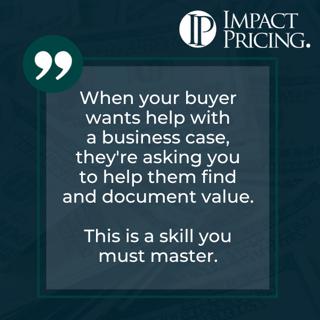
Pricing Table Topics: 8 of Hearts – Buyer Wants Help with a Business Case
This one is the 8 of Hearts from the Selling Value card deck. Oh, my gosh! If a buyer ever asked me to help them with a business case, I'm inside quietly jumping up and down rejoicing because they're asking me to do what I would like to be doing with them anyway. So, instead of me walking them through and convincing them that this is an important thing that they really want to know the answer to, they asked me. Oh, my gosh! And so, if they've asked me for help with a business case, what they're really asking for is, how do I convince my executives that we should be spending money on this problem? Or a better way to say that is, how do I document the value of solving these problems? How much additional profit are we going to make because we spend money to solve these problems? That is such a phenomenal place to be because inherent value, the value of solving the problems, is the piece of the puzzle that we as salespeople so rarely spend a lot of time on, and yet we should. Because not only does it help our buyer when they're trying to sell it internally, it helps them when they're trying to justify the pricing or spending the money on solving this problem. But it also helps us build a relationship with our client because we're demonstrating to them, we understand their problems. So, absolutely, if someone asks us to help them with the business case, don't look at that as a chore. Look at that as a golden opportunity because they just asked us to do what we really should be doing with them anyway. We hope you enjoyed this example of Pricing Table Topics. What you just heard was done without a script. If you want to get better at speaking about pricing and value, grab a deck of our cards, pick a card, read the saying, then talk for one to two minutes about what that card says. You'll become a better speaker and expert. If you have any questions or feedback, please email me, mark@impactpricing.com. Now, go make an impact. Connect with Mark Stiving: Email: mark@impactpricing.com LinkedIn: https://www.linkedin.com/in/stiving/
1 Maalis 20232min
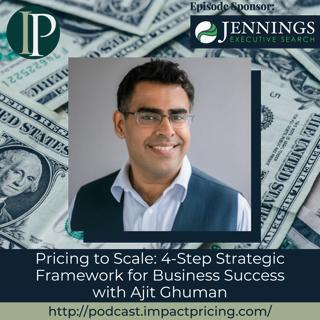
Pricing to Scale: 4-Step Strategic Framework for Business Success with Ajit Ghuman
Ajit Ghuman is the Director of Product Management, Pricing, Packaging, and Customer Experience at Twilio. He is the author of the book Price to Scale. He’s had Director of Product Marketing title at several companies, and he added pricing to his title in 2019. Ajit is fascinated by ancient mysteries. In this episode, Ajit educates us on pricing and packaging as he shares why he’s passionate when it comes to changing the monetization stack, especially on companies being able to change pricing strategies a lot quicker than today. Why you have to checkout today’s podcast: Learn how pricing can done through a four-step framework; Find out how to create a pricing system that can work well with all strategies; and Understand why it’s an advantage to be able to change pricing strategies quickly “I think of pricing in a four-step framework. The four steps are packaging, pricing metric, tariff structure, and then price point.” – Ajit Ghuman Topics Covered: 01:44 – How Ajit got into pricing 03:09 – Ajit talks about his book, Price to Scale, sharing the reason behind writing it and its key concept 04:40 – Backstory as to why Ajit wants to change the monetization stack 08:12 – Why the term quote to cash doesn’t bother Mark vs. how Ajit sees it 11:01 – We need better systems to let the strategy come to life 13:16 – How to create a code to cash (pricing) system that can work well with all pricing strategies 16:33 – Do companies do this practice in pricing? 18:30 – Talking about companies not monitoring usage of their product 19:59 – How often should companies tweak their packaging? 23:08 – How Ajit and Mark decide what feature goes into what package 25:31 – Why Ajit is a bit averse to good, better, best 29:40 – Ajit’s pricing advice 30:35 – Connect with Ajit Key Takeaways: “You have the best pricing strategy in the world, let’s say you hire Mark Stiving to help you with your pricing, and you have the best thing on paper, but your systems don't let you operationalize it, so you're stuck in the water. That's what I'm saying. We need better systems to let the strategy come to life.” – Ajit Ghuman “You're not going to have people write code all the time to do this. Otherwise, your main product will suffer. So just like you used to spend money on product analytics in the past or some other piece of core technology, I think there is a realization companies are having now, like somebody needs to build best practice products that do these things so that we can hook up into their APIs or their SDK and just do it.” – Ajit Ghuman People / Resources Mentioned: Price to Scale: https://ajitghuman.com/pricing-book/ Code to Cash podcast: www.codeto.cash/author/ajitpal/ Dor Sasson: https://www.linkedin.com/in/datapm/ Connect with Ajit Ghuman: LinkedIn: https://www.linkedin.com/in/ajitpalghuman/ Email: ajit@pricetoscale.com Connect with Mark Stiving: LinkedIn: https://www.linkedin.com/in/stiving/ Email: mailto:mark@impactpricing.com
27 Helmi 202330min

Blogcast: Another Ridiculous Fee
This is an Impact Pricing Blog published on January 18, 2023, turned into an audio podcast so you can listen on the go. Read Full Article Here: https://impactpricing.com/blog/another-ridiculous-fee/ [powerpress] If you have any feedback, definitely send it. You can reach us at mark@impactpricing.com. Now, go make an impact. Connect with Mark Stiving: Email: mark@impactpricing.com LinkedIn: https://www.linkedin.com/in/stiving/
24 Helmi 20232min
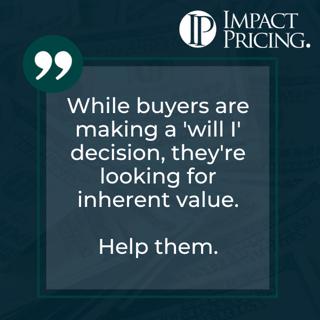
Pricing Table Topics: 8 of Spades – Buyers on a Trust Journey are Not Price Sensitive
This one is the 8 of Spades from the Selling Value card deck. When buyers are making a 'will I' decision, they're trying to decide, should I spend money to go solve this problem or not? Oftentimes, when they're making a 'will I' decision, they've got some problem that has boiled up, that's become an important problem, and they say, "Hey, maybe I'm gonna go consider buying a replacement, a solution, something to solve this specific problem for me." If you are in B2B sales, what your job needs to be at this moment is, what is the basic problem your buyer is trying to solve? Once we understand that problem, we can help them figure out what's the value of solving that problem. What this really means is, can we do an ROI calculation? At least the R part of an ROI calculation. Can we help the buyer figure out how much more profit will they make because they buy our product? This is called inherent value. Inherent value is what's the value of solving the problem, and it has nothing to do with, what's the value of your product relative to your competitor's products. We want to be thinking and helping our buyers think, what's the value of solving the problem? As salespeople, we always want to be thinking, what's the decision a buyer is making right now? What's the information that buyer needs to help make that decision? And when they're making the 'will I' decision, what they're trying to decide is, is this problem worth me spending my money to go solve? That's why we help them with the inherent value. We hope you enjoyed this example of Pricing Table Topics. What you just heard was done without a script. If you wanna get better at speaking about pricing and value, grab a deck of our cards, pick a card, read the saying, then talk for one to two minutes about what that card says. You'll become a better speaker and expert. If you have any questions or feedback, please email me, mark@impactpricing.com. Now, go make an impact. Connect with Mark Stiving: Email: mark@impactpricing.com LinkedIn: https://www.linkedin.com/in/stiving/
22 Helmi 20232min
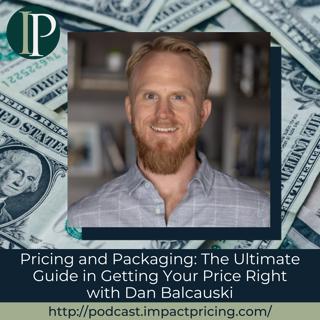
Pricing and Packaging: The Ultimate Guide in Getting Your Price Right with Dan Balcauski
Dan Balcauski was a program leader for Northwestern University, where he also went to school seven years prior. He is the founder and Chief Pricing Officer of Product Tranquility, a company that helps high volume B2B SaaS CEOs define pricing and packaging for new and existing products. In this episode, Dan talks about pricing and packaging and how he applies its principles in helping B2B SaaS companies. Why you have to check out today’s podcast: Learn about the similarities and differences of pricing model and pricing metrics Discover the fundamental principles of how to decide which features to put on which packages Understand why there is no such thing as absolute and optimal pricing “You don't really have a choice of whether you will have a pricing conversation with your customer. The only decision you get to make is when you're going to have that conversation. So I recommend having it as soon as possible.” – Dan Balcauski Topics Covered: 01:13 – How Dan got the title “Chief Pricing Officer” 02:04 – The work that Product Tranquility does 02:16 – Dan’s thoughts on packaging 04:31 – How Dan defines pricing metrics and pricing model 10:24 – How Dan decides which features go to which packages 16:50 – Dan’s thoughts on good, better, best packaging 18:51 – How to decide if a specific feature shall go to good, better, or best packages 21:21 – How you should name your packages if you want to call them other than “good, better, and best” packages 23:24 – Dan’s favorite thing to share people about pricing and packaging 26:08 – Do product managers use the word “value” the same way that pricing people do? 28:27 – Dan’s pricing advice 29:58 – Connect with Dan Balcauski Key Takeaways: “When it comes to, especially SaaS pricing, most executives think that what you charge determines your success. In fact, who and how you charge determines your success. And the packaging is a huge element of how you charge. It really helps tell and align your value story so your sales and go-to market teams can really get your message across of the differentiated value that you bring.” – Dan Balcauski “In general, the principle by which I look at this through, is that your bundles, offer configurations, and packages, in Mark's terms, should align to a particular customer segment.” – Dan Balcauski “If we understand at a deep level what our customer segments need, what their constraints are, what they value, then we can make that decision much easier for them, which increases our sales velocity, reduces our customer acquisition costs, et cetera.” – Dan Balcauski “If we don't understand the customer we're going after, the problems they have, the outcomes they want, the constraints that they face upfront, the rest of the conversation gets very muddled.” – Dan Balcauski “There's the right price for the right moment in time for your stage of company, for the life cycle of your industry, for your competitive environment. But you're going to learn, you're going to get better.” – Dan Balcauski Connect with Dan Balcauski: LinkedIn: https://www.linkedin.com/in/balcauski/ Website: https://www.producttranquility.com/ Connect with Mark Stiving: LinkedIn: https://www.linkedin.com/in/stiving/ Email: mailto:mark@impactpricing.com
20 Helmi 202331min













